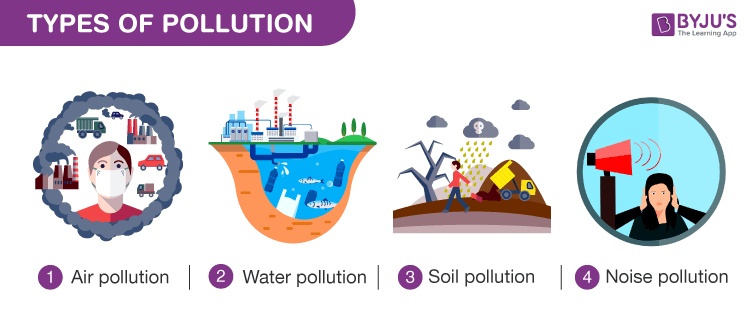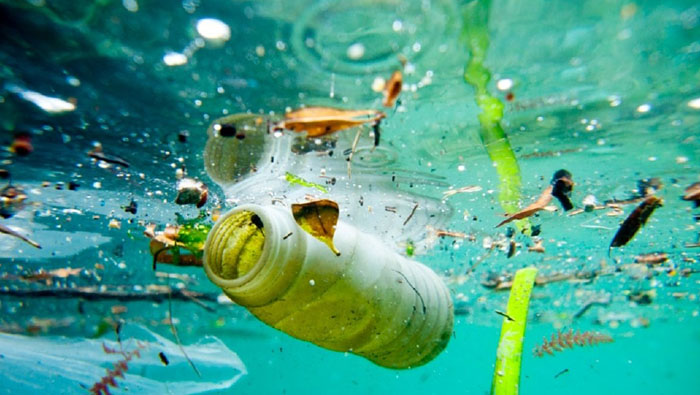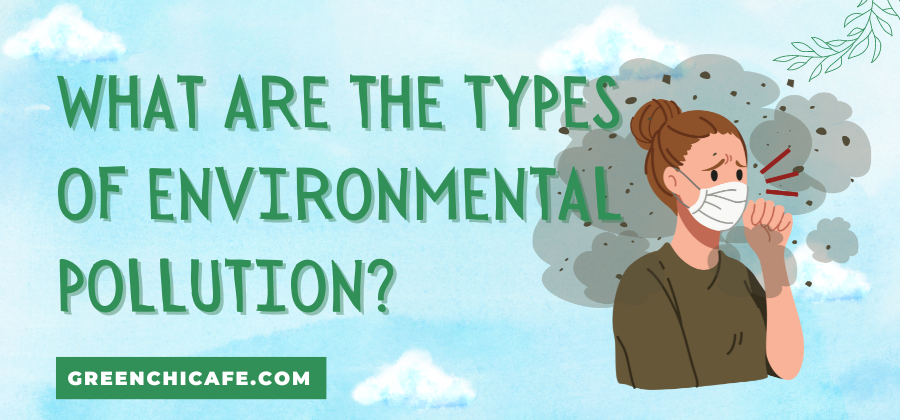Last Updated on June 3, 2024 by Annie Baldwin
Environmental pollution is a growing concern across the globe.
Understanding the major types of pollution is an important first step to combating this issue.
In this article, we’ll explore the main forms of pollution that affect our planet
What Are the Types of Environmental Pollution?

The main types of environmental pollution include air pollution, water pollution, soil pollution, noise pollution, radioactive pollution, light pollution, thermal pollution, visual pollution, plastic pollution, and space pollution.
Key pollutants are greenhouse gases, heavy metals, pesticides, fertilizers, and plastic waste.
Key Points
- The main types of pollution are air, water, soil, noise, radioactive, light, thermal, visual, plastic, and space.
- Major pollutants are greenhouse gases, heavy metals, pesticides, fertilizers, and plastic waste.
- Pollution threatens human and ecosystem health globally.
Our Opinion
Environmental pollution is one of the biggest challenges facing humanity today, as seen in South Asia.
As experts in this field, we believe it is imperative that individuals, governments, and corporations work together urgently to implement solutions that can mitigate key pollutants and protect our planet for future generations.
Tackling air and plastic pollution should be a top priority, along with transitioning to clean energy and sustainable agriculture globally.
With collective action and political will, we can curb environmental degradation and build a greener, healthier future.
What is Environmental Pollution?

Environmental pollution occurs when harmful substances are introduced into natural environments like air, water, or land. There are several major types of pollution:
- Air pollution – Release of chemicals and particulates into the atmosphere. Examples include carbon monoxide, sulfur dioxide, ozone, and nitrogen oxides.
- Water pollution – Contamination of water resources like oceans, rivers, and groundwater. Examples include industrial waste, sewage, plastics, and fertilizers.
- Soil pollution – Degradation of the soil through the introduction of chemicals, waste, or over-farming. This can lead to loss of fertility.
- Noise pollution – Unwanted sound that disrupts natural environments and human health.
- Light pollution – Excessive artificial lighting that obscures starlight and disrupts ecosystems.
Pollution can have serious consequences like respiratory disease, cancer, and disruptions to entire ecosystems. Understanding the main types of pollution helps us to identify sources and work to prevent further contamination of our shared environment.
Types of Environmental Pollution

While the types of pollution listed above represent broad categories, there are numerous specific pollutants that contribute to each one. Here are some of the major pollutants and their impacts:
- Air Pollution: Nitrogen oxides, sulfur dioxide, particulate matter, volatile organic compounds, chlorofluorocarbons, and radioactive pollutants.
- Water Pollution: Heavy metals like mercury and lead, fertilizers and pesticides, plastics and microplastics, petroleum products, sewage, and radioactive waste.
- Soil Pollution: Heavy metals, chemical pesticides, chlorinated solvents, oil, and fuel waste.
- Noise Pollution: Traffic, industrial machinery, construction, public events.
- Light Pollution: Street lights, advertising, commercial and residential buildings.
Each of these pollutants can have detrimental effects. For example, nitrogen oxides and sulfur dioxide contribute to acid rain, which harms forests and water bodies. Microplastics in oceans poison marine life. Excess noise from traffic and construction can increase stress and disrupt sleep.
It’s clear that pollution poses a major threat to planetary health. But thankfully, there are steps we can take as individuals and societies to limit pollution. This includes reducing energy consumption, properly disposing of waste, advocating for cleaner production practices, and choosing more sustainable options. What matters most is that we continue to learn about different types of pollution so that we can make informed choices to protect our shared environment.
Air Pollution
Air pollution refers to the release of pollutants like gases, particulates, and biological molecules into the atmosphere. Some major air pollutants include:
- Nitrogen oxides – emitted from high-temperature combustion
- Sulfur dioxides – especially from burning fossil fuels
- Carbon monoxide – from incomplete combustion
- Volatile organic compounds – from industry and vehicles
- Particulate matter – like dust, dirt, soot, and smoke
Exposure to air pollution can have serious health effects. Nitrogen oxides and sulfur dioxide contribute to respiratory problems and aggravate existing heart and lung diseases. Particulate matter penetrates deep into the lungs and can cause issues like asthma, chronic bronchitis, and aggravated heart disease.
Other effects include reduced visibility and damage to plants, animals, infrastructure, and buildings from acid rain. Long-term exposure is linked to an increased risk of cancer as well as neurological, reproductive, and developmental damage.
Reducing air pollution requires controlling industrial emissions, promoting public transit over private vehicles, switching to clean energy sources, and improving fuel economy and emission standards for automobiles. As individuals, we can walk, bike, or take transit more, reduce energy use, and advocate for clean air policies.
Water Pollution
Water pollution occurs when harmful substances like chemicals, pathogens, and solid waste are released into water bodies. Major water pollutants include:
- Sewage and wastewater from homes, farms, and industry
- Runoff from roads, construction sites, and urban areas
- Leaking from landfills and mining sites
- Oil spills and leakage from ships
Water pollution can spread disease, destroy aquatic life, and make water unsafe for drinking and recreation. Pathogens from sewage can cause illnesses like cholera and typhoid. Nutrient pollution fuels algal blooms that suffocate fish and create dead zones. Toxins like mercury and lead build up in fish, harming wildlife and people who eat contaminated seafood.
Preventing water pollution involves reducing runoff through wetland restoration and green infrastructure, regulating discharges from factories and sewage plants, and proper waste disposal. As individuals, we can cut pesticide and fertilizer use, properly dispose of hazardous chemicals, and reduce plastic waste entering waterways.
Soil Pollution
Soil pollution occurs when harmful chemicals and toxins are released into the ground. Major causes include:
- Industrial activities like mining, smelting, and refining
- Waste disposal including landfills and illegal dumping
- Agricultural practices like pesticide overuse and excessive fertilizers
- Oil and gas extraction and spills
Pollutants can alter soil chemistry, degrade soil quality, and lead to erosion. Toxic metals like lead and cadmium can accumulate in plants or leach into groundwater. Pesticides and herbicides harm helpful soil organisms. Hydrocarbons from oil spills reduce fertility. Acid rain accelerates soil degradation.
Preventing soil pollution requires properly disposing of industrial and agricultural waste, regulating emissions, and using greener practices. As individuals, we can use natural fertilizers and pest control, avoid overapplying chemicals, and grow native plants to stabilize soil.
FAQ
What Are the 7 Types of Environmental Pollution?
The 7 major types of environmental pollution are air pollution, water pollution, soil pollution, noise pollution, radioactive pollution, light pollution, and thermal pollution.
What Are the 10 Types of Pollution?
The 10 major types of pollution are air pollution, water pollution, soil pollution, noise pollution, radioactive pollution, light pollution, thermal pollution, visual pollution, plastic pollution, and space pollution.
What Are 5 Major Environmental Pollutions?
The 5 major types of environmental pollution are air pollution, water pollution, soil pollution, noise pollution, and plastic pollution.
Which Are the Main Pollutants of Environment?
The main pollutants of the environment include carbon monoxide, sulfur dioxide, nitrogen oxides, particulate matter, volatile organic compounds, chlorofluorocarbons, heavy metals like mercury and lead, pesticides, fertilizers, and plastic waste.
Conclusion
Environmental pollution remains a major threat to human and ecosystem health globally. The main types of pollution affecting our environment are air, water, soil, noise, radioactive, light, thermal, visual, plastic, and space pollution. Key pollutants responsible for environmental degradation include greenhouse gases, heavy metals, pesticides, fertilizers, and plastic waste. Tackling pollution through better environmental policies, technological solutions, and increased public awareness is crucial to creating a sustainable future.
